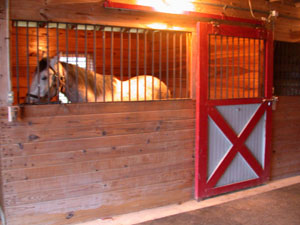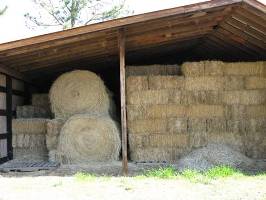Colleen M. Brady, Department of 4-H Youth Development; K.S. Kanne, Department of 4-H Youth Development; and Mark Russell, Department of Animal Sciences, Purdue University
Owning a horse can be an incredibly rewarding experience. However, certain decisions must be made if you are going to be prepared for this undertaking.
Housing
Before choosing housing for your horse, ask yourself the following questions:
Where will I keep the horse?
- A horse owner can choose to either board the horse at their home or at a professional boarding facility.
What are the horse’s needs?
- The animal needs only shelter from the wind and weather and a dry place to eat. Don’t confuse what will make you as the horse owner more comfortable with the horse’s basic needs.
What do I intend to do with my horse?
- If you want to show early in the year, you will need a place to ride all year — and possibly an arena — to fit and condition the horse.
What can I afford? You can spend as much as you want to on a horse facility. Estimate $7 per square foot of floor space as the absolute minimum cost to build an enclosed barn for horses. Cost will increase as amenities are added.
Fencing
Safe and adequate fencing is a vital part of a horse facility, either your own, or the place where you choose to board. All horses should be allowed as much outside, free exercise as possible. This will reduce the incidence of stable vices, as well as contribute to the general overall health of the horse. This is especially true in the case of foals and young horses, who have fewer problems with respiratory diseases and more normal bone development when they are housed outside with unlimited exercise.
When choosing fence material, find one that is sturdy, yet will not injure an animal caught in it. The most common types of fencing are wooden post and hardwood board, post and rail, poly vinyl chloride (PVC), woven wire, electrified wire, or a combination of them. All line fences should be at least 4 feet high, and solidly constructed. As a general rule, the smaller the paddock, the stronger the fences need to be. Wooden fences are very appealing to the eye, but cost and maintenance can be high. PVC fencing is becoming increasingly popular because you can get the look of wooden fence without the maintenance. However, PVC is a more expensive option than many of the others.
Feeding
Horses, like people, have specific nutritional requirements. The nutrients of greatest concern to horsemen are water, salt, protein, calcium, phosphorus, vitamins A, D and E, and energy. Horses are divided into five nutritional classifications based on the demands of their workload. The classifications are:
Maintenance
- Not growing, pregnant, lactating, or doing significant work. Most pleasure horses fit here.
Gestation (Pregnancy)
- Increased nutritional requirements the last third of pregnancy.
Lactation
- Mares that are actively nursing foals. Very high nutrient requirements, especially at the beginning of lactation.
Growth
- Increased protein and energy requirements until full skeletal growth is reached at approximately 5 years.
Work and Exercise
- The harder the horse is working and being exercised, the more energy it will need in its diet.
The horse, unlike ruminants, such as cattle, goats and sheep, has a relatively small capacity for feed in his digestive tract. Horses can consume about 2.5 percent of their body weight per day. As a nibbler and grazer, horses are best fed smaller quantities of feed, especially concentrate, at least twice per day at about 12- hour intervals. That means a 1,000-pound horse will eat about 25 pounds of feed per day of which at least half should be forage, including pasture, hay or hay cubes.
Water
Clean, fresh water and trace-mineralized salt should be available regularly or on a free-choice basis on pasture or in the barn. The average 1,000-pound adult horse can easily drink 10 to 12 gallons of water a day. Horses will suffer more quickly from a lack of water or salt than if they are forced to go without feed.
Feed Storage
All feed should be stored in a clean, dry, secure area that is inaccessible to the horse, even if the horse gets loose. A separate grain room with a secure door is ideal. Protect the feedstuffs from the weather, as well as from vermin such as mice, rats, raccoons and opossums. Fifty-five gallon drums or plastic garbage tubs with lids work well for concentrates. Hay should always be off the ground or floor on pallets to allow for air movement to prevent mold. Hay is combustible and can spontaneously ignite; therefore, it is preferable to store the majority of your hay in a separate site from the barn where the horses are housed, with just enough hay in the barn for a week’s feeding.
Health
Horses are susceptible to a variety of diseases, as well as both internal and external parasites. To keep your horse healthy, it is important to vaccinate against diseases, deworm regularly and properly care for teeth and feet. Establish a regular program with a local veterinarian and farrier then let them help you make health-care decisions.
Daily Maintenance
Grooming, waste removal and exercise need to be done regularly for your horse to maintain good health. This takes time and, of course, the proper equipment. To do an adequate job, you will need: brushes, towels, combs, currycombs, hoof picks, manure forks, shovels, rakes, a wheelbarrow, manure spreader, a bridle, saddle, saddle pad, halters, lead rope and lunge line. It is not necessary to have fancy equipment, but if you are going to do the needed chores, then some tools must be available.
Grooming
Grooming your horse serves two functions. It removes excess dirt and hair to produce a better coat and circulation, and it gives you a chance to thoroughly inspect your animal for injuries, swellings and abnormalities. Furthermore, it is an opportunity to spend time with your horse and strengthen the bond with your equine partner.
Begin grooming by loosening dirt with a rubber currycomb used in a circular motion. Feel free to apply as much pressure as your horse is comfortable with, as this is a massage for the horse, as well as a method of dirt removal. Because the rubber currycomb is hard, it should be used only above the knees and hocks, and not on the face. The next step is to use a stiff brush, called a dandy brush, to remove the loosened dirt. Brush briskly in the direction of the hair, with a flicking motion to remove the dirt and debris from the hair coat. Continue by going over the animal once again with a soft brush, stroking with the grain of the hair and then towel off the excess dust. Use a hoof pick to remove any dirt or stones from the animal’s feet and finish by combing out the mane and tail. It is important to remember that although the horse may enjoy a vigorous grooming, the lower legs and face are very sensitive and should be treated accordingly.
Waste Removal
Cleaning stalls can be an important part of your daily aerobic exercise. Horses kept, or fed, inside should have their stalls cleaned once a day. Do not remove all of the bedding, just the soiled or wet bedding and manure. Most horses are habitual in their eliminative behavior; so after you have cleaned the stall a few times, you will learn where the horse urinates and defecates, which will hasten the cleaning process. Once a week or so, the stall will need to be stripped, with all bedding material removed, and allowed to dry. Ideally, the horse could be left outside for a while, and the wet spot can be left open to the air. If that is not possible, put dry bedding in any wet spots to soak up the moisture then remove. Sprinkling agricultural lime on the floor of the stall will act as a mild sanitizer and keep the moisture and odor down, but lime should always be covered with bedding before the horse is returned to the stall.
Manure should be removed from pastures periodically. The frequency will depend on the concentration of horses. All manure should be properly composted before use on livestock ground to kill any parasites and parasite larvae. Do not spread uncomposted horse manure on horse pastures, as this will recontaminate the pasture with parasites. Horse manure is an excellent source of nutrients for cropland, gardens, landscape companies and nurseries; or you may be able to have it removed by a local waste management company.
Exercise
Exercise for the horse takes various forms. Riding, driving, lunging and turning out the animal are all satisfactory methods. If your horse is kept outdoors, it will exercise to some degree by walking around. However, stalled horses should be out for at least 60 minutes each day. You cannot allow a horse to stand in a stall or not be ridden for months and expect to go riding for three to four hours without problems. Remember, the horse is an athlete, not a machine, and requires conditioning to be fit. Horses also must be warmed up before any type of stressful activity. The walking around the horse does in a pasture will not condition it for heavy riding. Conditioning horses is based on the same principles as conditioning any athlete, so keep that in mind when determining if your horse is fit enough for a particular activity.
Never allow your horse to eat a meal or drink unlimited water immediately after exercising because this can cause colic or founder. The most effective way to cool the horse out is to remove the tack, hose the horse down to remove sweat and dirt, and walk the horse at its own pace, allowing it to take a few sips of water periodically. Once the horse is completely cooled out, it can have as much water as it desires. Grooming or hosing-down the horse after exercise will remove sweat and dirt and provide an opportunity for you to examine the horse and make sure it didn’t receive any injuries during the exercise period. Putting the horse away clean will also reduce itching and irritation to its skin and improve hair coat quality.
Summary
As you can see, there are many things to be considered before you decide to undertake keeping a horse on your own. Initially, you might be better off boarding the horse with someone else, but if you own more than one horse, the right decision may be to bring them home. Managing horses takes a lot of planning, time and dollars. The more research and fact-finding you can do before you bring the horses home, the greater the chance of having a positive experience for both you and the horse. It may also be advisable to spend some time with a knowledgeable horse person in your area to learn how to take proper care of your horse. This has been a brief review of the areas of management needs for horses. Contact your county extension office, or the extension Web site, for more information on horse management.
Colleen M. Brady, Department of 4-H Youth Development; K.S. Kanne, Department of 4-H Youth Development; and Mark Russell, Department of Animal Sciences, Purdue University






